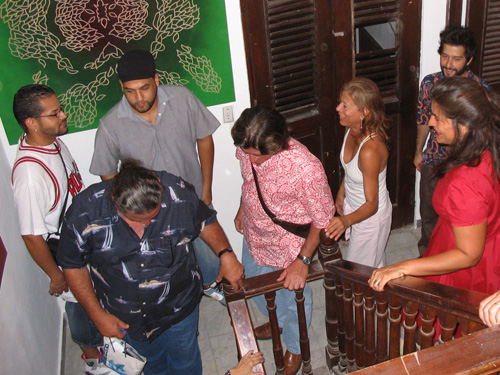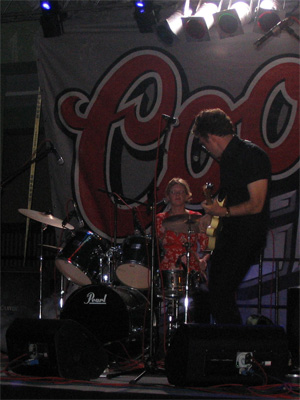
What’s the Frequency, Pedro?Who says that an online magazine has to be pudding plain, vanilla, with one damn point-of-view ad infinitum, ad naseam, and ad hoc? Beginning with this action- packed edition, Rotund World presents an entirely different strident voice for your unfettered annoyance and disgust, the inimitable Pedro Vélez. Lest anyone think that this is an egregious conflict of interest—so many times has Pedro’s name been given Rotund play—believe us when we say that he is no friend of Rotund World. Take it away, Pedro. Martin Creed’s Wit Failsby Pedro Vélez “All of the bells in a city or town rung as quickly and as loudly as possible for three minutes,” October 20 and 21, 2006, in Old San Juan, Puerto Rico. With the sound of the bells of Capilla de las Siervas de María, Catedral de San Juan, Iglesia Metodista de la Santísima Trinidad, Iglesia de Santa Ana, and Iglesia de San Francisco.
A rooftop view of Viejo San Juan, awaiting the bells. Loud bells, poetry, and hope in the colonial city of San Juan. Reminds me of those bells in the sky at the ending of Lars Von Trier’s “Breaking the Waves.” This is one of those events that you just want to love but can’t. Even more so when Martin Creed is one of my so-called ‘heroes.’” As I remember, in ’97 Creed was part of a group of jugglers of re-appropriated objects, along with Ceal Floyer, Tony Tasset, and a bunch of other post-minimalists. They made academic product with half-assed functionality and stylish sarcasm, and it was IT, it was in. But what happens when the piece is all title—“All of the bells in a city or town rung as quickly and as loudly as possible for three minutes”—and no action? How does one react when the expectancy of what the piece could be is the piece itself? The answer is “one doesn’t,” because the proposition is anticlimactic. In sports, although teams lose most of the time in search of a championship, they produce great plays, memorable games, physical feats, and a world of entertainment for many months. All of this is later analyzed to death by pseudo reporters drawing endless conclusions based on possibilities of what the next season is going to bring. With possibilities and statistics comes the payoff, the money shot. The great industry and its limbs, working as a unit, have created substance and gently shaped it into a perfectly designed package of goods. When popular musicians present an album, they include at least ten songs that the public can buy, download, and play endlessly. Not all the tunes are masterpieces. In the mix one or two gems are sure to surface, but it’s the grouping—the package and the look—that make it an experience worth digging into, a cohesive body of work regardless of the quality or intellectual depth of single units. Even bad bands, or what VH-1 calls “awesomely bad,” can become important and relevant. Never mind the poor craftsmanship or how shallow or cheesy the poetry is; the music manages to provoke an effect and a feeling in the public. And the public accepts responsibility for its embrace of triviality and fun for fun’s sake. Bad, simple music written and performed by bad bands can make for great Pop music. But just as musicians make lousy artists, great artists are almost always awful musicians. Take David Byrne without The Talking Heads, Bob Dylan the “painter,” or Yoko Ono and John Lennon and vice versa. With the highbrow arts, the dynamics are similar but the art viewer reacts differently, more prone to twisted perception. Most of the time, a bad outing by an artist is neutralized by an unlimited grouping of gestures, production that, once presented in an exhibition, gives the viewer the general idea, a sense of body or unity. As long as the viewer finds that one drawing or collage among all the crap, that’s sufficient to proclaim failure good enough and, therefore, the personality behind it a good artist. The effort in finding the gem among the rubble makes the experience worthwhile, even if a scavenger hunt is not what the viewer expected. Furthermore, that positive reaction is usually not sustained until the show gets the stamp of approval of sales or an important critic, or the artist, being a great person, simply gets a pass. With popular music we usually discard the CD without hesitation if the music is not up to our taste. In sports the manager admits failure, and people get fired for it. Film critics call bad, high-budget blockbusters trash using only three lines, and TV shows get canned with the smallest downturn of ratings. Faced with Martin Creed’s piece—the sounding of many bells from churches in all of San Juan for 3 minutes on each of two weekend nights—one is forced to question the intentions, the purpose, and the relevance of the act.
Revelers descending a staircase. Why am I with a selected group of people listening to the bells from a rooftop instead of in the streets? What is the reaction of the residents of the old city who are walking the streets? Are the neighbors—natives, Puerto Ricans—supposed to know this is happening, or is this act being imposed on them? If so, why? What kind of feeling is this act supposed to evoke? Is a university working on a study to measure the impact of public art on the city’s inhabitants? Or is this project a large-scale vanity act? For three minutes on Friday the bells did just what the title of the piece ordered. The bells from the old churches crashed like pots and pans falling on a distant kitchen floor. But there was no reaction, no talk of bells later in the night in any of the bars, because the bells didn’t reverberate loud enough. As for those who weren’t upstairs, what was heard from the rooftop doesn’t travel as easily on the ground. Furthermore, who was going to be alert if there was no promotion, only a handful of posters? Once the unwilling art casualties could react to the tilting of the bells, it was too late; minute number three in a noisy city packed with tourists, loud clubs, restaurants, dirty pigeons, the sea, and the heavy afternoon traffic. On Saturday the reports were bleak and sad. A few of the churches backed out of the synchronized sounding of the bells. One was off synch, sounding twenty minutes after the hour. How many of the bells did go off that day and how loud, we’ll never know. How to experience an anticlimactic, lazy public intervention with no public and no consequences when expectations were high for an exciting, hopeful act? Martin Creed and his Band After the bells, Creed’s second public outing occurred Saturday night with a free concert at the public Plaza San José. Not as a headliner but as part of the lineup of the famous Candela Music Festival, an annual October event produced by Pablo Rodríguez.
Martin Creed, right, and band. Creed’s three-piece band played in front of a handful of art lovers, plus two unknown boogiers in summer dresses “dancing like it was 1999.” The songs, which Creed conceives of as art, have a nonchalant easiness, a minimal undertone à la Franz West. For fellow artists, I’m sure seeing a respectable member of the club taking such a risk in public can be intriguing and even funny, like watching a family member catch a foul ball in Yankee Stadium on the evening news. When compared to the only other work Creed presented on the island, one notices his general confusion of structure and purpose. In the case of the music, the songs/pieces have no identity. The band lacks able musicians—including Creed as the lead singer—and the “look” of the band is not memorable and, therefore, not catchy. I assume the idea is to mimic Pop or music in general. Just look at the work of other artists who derive tactics, form, and functionality from Pop, like Paper Rad or the one-minute sculptures of Erwin Wurm featured in a music video by the Red Hot Chili Peppers.
Creed gets down. And down. And down. In the song titled “Words,” for example, the artist repeats the word “word” over a three-cord composition, with the enthusiasm of a robot. Though not nearly as good, it was reminiscent of some of the contemptuous yet cool repetition of the chorus by bands like Nirvana, the contained anarchy of the Boredoms, or the constant beats of reggaetón artists like Daddy Yankee and Luny Toones. Creed’s performance was as exploitative as a graduate student exercise in Conceptual Art, with no narrative, no sarcasm, and no irony. The “music” was just a thing, or maybe the band was supposed to be a sculptural element. More confusing was the fact that the “music” was not even irritating or bothersome; simply flat like the bells, meant to be experienced in very limited time, six minutes total, with nothing to bounce off of. It might have been helpful to see a handful of Creed’s most simple sculptural editions or pieces exhibited at a museum, institution, or gallery. It seems like the artist has not found a way to finish this series. Maybe next time the island will get a different perspective and a broader vision of his truly ingenious wit and work. For now he missed the World Series. There is always next season. Pedro Vélez is an artist, curator, and commentator of the arts vacationing in Puerto Rico. For our last words on recent shows, proceed to the following page. |




